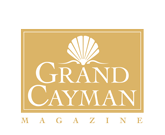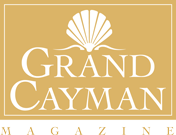It’s a midsummer evening in Anchor & Den and the circus has come to town. Amid bunting and balloons, a well-heeled crowd clamors for vodka-laced cotton candy and Zacapa 23 rum edible blowing bubbles. It’s the Big Top for grown-ups.
Sporting a glittery gold bowler hat, the bartender invites them to “roll up” for a candied popcorn Old Fashioned, made with butter-washed Bulleit bourbon, Johnnie Walker Platinum, salted caramel syrup and orange cream citrate. Across the room, the scene is no less surreal as pine vapor wafts from a bar festooned in ivy, and cocktails carry the botanical notes of cucumber bitters, strawberry vermouth, black pepper-infused vodka and elderflower.

Two young finalists were vying to represent Cayman at the World Class championships, the global cocktail-making trials dubbed “the Olympics of bartending.” After warding off seven other competitors in a speed cocktail-making round and “mystery box” ingredients challenge the day before, the highest-placing two were given just 24 hours to each create a unique pop-up bar. The evocative “Secret Garden” offering by Fede Gisbert Johnson of the Backroom bar was ultimately trumped by the Ritz-Carlton’s Amba Lamb with her interactive “Carnival” concept. It secured the New Zealander a spot at World Class in August, held in Mexico City, with the chance of being crowned the planet’s best bartender.
Rewind 10 years and this level of immersive, creative mixology was unheard of in Cayman. Since then, a renaissance of high-end drinking has seen saccharine pre-mixed Pina Coladas and generic rum and cokes supplanted by fresh local ingredients, craft spirits, and innovative techniques.
“The changes have been pretty massive,” observes Diageo Reserve Brand Ambassador Simon Crompton, a Brit who has lived in Cayman for 11 years. “Quality mixers, various types of ice, the use of bitters, shrubs and syrups, detailed knowledge of brands… all are now virtually expected in most Cayman bars.”
“We don’t want people to drink more; we want them to drink better – better ingredients, better quality, better glassware, better atmosphere,” he adds.

Creating a scene
The demand has been supplied by residents and visitors alike who now want drinks on par with those available in cities such as London or New York. This goes hand-in-hand with the wider consumer interest in the provenance and quality of all food and drink, whether they are ordering a steak or a Sidecar.
Figures such as Jo Austin at Jacques Scott have equally been instrumental in building a buzzing local mixology culture via well-marketed events, the biggest of which is Cayman Cocktail Week, celebrating its fifth anniversary in October 2017.
The week sparks a series of unusual, hands-on happenings across the island from all manner of businesses: In 2016, this ranged from South West Collective’s Whisky Lab – a two-hour seminar, tasting and blending session about Scotch – to a “Treasure Island” Tiki-themed pop-up with Books & Books, and even a musical cocktail-making challenge at Macabuca.
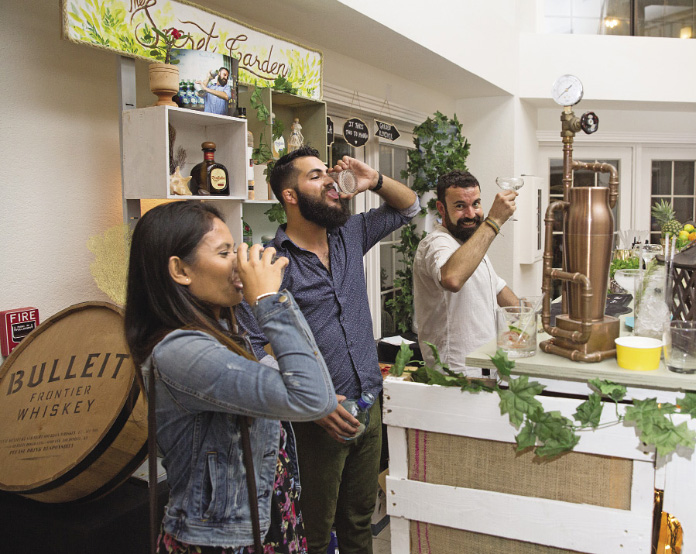
Culinary art meets cocktail craft
Cayman’s already established gastronomy scene is another positive force in elevating its cocktail culture. Amba, for instance, comments that working closely with the Ritz-Carlton’s renowned chefs has been instrumental in her progress: “I have had access to some amazing minds in our kitchens all around the resort. They have helped me a lot with new techniques and equipment.”
Demonstrating that cocktails can rival fine wine as a suitable accompaniment with dinner, earlier this year Jacques Scott hosted a VIP cocktail-pairing banquet at Michelin-starred restaurant Blue by Eric Ripert. The tasting menu matched tuna foie gras with a cocktail of Johnnie Walker Blue Label whisky, homemade tepache (a Mexican beverage of fermented pineapple), lemon juice, and honey. This was followed by a scallop and wild mushroom dish served with applewood-smoked and brown-butter washed Bulleit bourbon. The final sweet note was a white chocolate and passion fruit pudding with a coconut-fat washed Don Julio 1942 tequila and white crème de cacao.
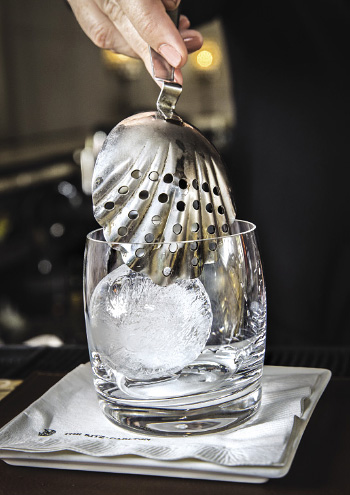 A bounty of fresh local ingredients is at mixologists’ fingertips on-island, thanks to a flourishing farm-to-table – or, should we say, farm-to-glass – movement. A ripe local mango is almost certainly going to produce a better cocktail than an artificial, preservative-packed juice. Then there are all manner of less obvious Cayman-grown herbs, flowers, spices, and even salt for bartenders to utilize.
A bounty of fresh local ingredients is at mixologists’ fingertips on-island, thanks to a flourishing farm-to-table – or, should we say, farm-to-glass – movement. A ripe local mango is almost certainly going to produce a better cocktail than an artificial, preservative-packed juice. Then there are all manner of less obvious Cayman-grown herbs, flowers, spices, and even salt for bartenders to utilize.
Simon, for one, is keen to see Cayman’s distinctive heritage and culture expressed through these crafted drinks. “Whenever I did competitions, I always tried to use local products such as Guava jam, honey, or sorrel, and would weave in some of the history of Cayman into the presentations,” he explains. “Different bars will have different themes, and we can learn a lot from bartenders abroad and big cities, but in the end we are a Caribbean island and that should always be a factor when creating cocktails.”
International standing
Traveling across the Caribbean to promote quality spirits, Diageo Reserve Brand Ambassador Rafael Reyes has an informed view on how Cayman’s cocktail scene is perceived. “It’s now regarded as one of the main contenders in the region and definitely has raised the bar in the Caribbean,” he agrees. “It is in a unique situation where you can find a concentration of bartenders from all over the world. Many of these bartenders come from high-end bars and are now applying their knowledge and skills in the island.”
 These talents have certainly not gone unnoticed at the World Class contests, where Cayman bartenders have managed to break into the final top 20 in recent years – despite going up against countries with long established cocktail scenes, such as the U.S., Australia and the U.K.
These talents have certainly not gone unnoticed at the World Class contests, where Cayman bartenders have managed to break into the final top 20 in recent years – despite going up against countries with long established cocktail scenes, such as the U.S., Australia and the U.K.
“The perception of our cocktail scene is pretty incredible given the size of our island,” Simon agrees. “We are still one of the only Caribbean islands that participates in global cocktail competitions.” He personally competed in 2013, the first year Cayman entered World Class, which took him to a luxury cruise ship in the Mediterranean. He placed 11th out of the 55 countries involved. Following in his footsteps was Laurie Eaton, currently KARoo’s head bartender, who finished in the top half of the table in Miami 2015.
So, what kind of hurdles can contestants expect? Each year different challenges are devised to test every skill a bartender should possess. Last year this included a “Before and After” challenge for creating a new before- and after-dinner drink; “The Shape of Cocktails to Come,” a chance to showcase their view of what drinks would be like in the future; and “Cocktails against the Clock,” in which they must whip up between five and 10 complete cocktails within 10 minutes.
Onwards and upwards
To maximize the island’s potential, attention is turning to developing opportunities for the next generation of bartenders.
Jacques Scott is in discussions with the National Workforce Development Agency about putting a training program together, and the retailer’s brand manager, Jo Austin, is hopeful that such a scheme would help nurture Cayman’s homegrown talent. “I’d love to see more local Caymanians behind the bar and coming forward to represent Cayman in competitions like World Class,” she says.
Wineschool 3’s Wine & Spirit Education Trust-approved courses are currently an excellent option on-island for bartenders – or indeed anyone interested in mixology – to build their understanding of core ingredients. Amba is a compelling case in point, as before her World Class success she became a Certified Sommelier along with gaining qualifications in both Sake and Beer. She reflects that these steps “really elevated my knowledge and palate.”
Competitions also have a positive impact on nurturing talent – a platform for further training and encouraging individuals to up their game. “Every year the [World Class] competition has got bigger, better, and tougher, and the standard has gone through the roof,” Simon explains. “We always bring a bartending expert or spirit specialist over, who can teach the bartenders about new techniques or explain the intricacies of how the spirit is made or the flavor profile.”
“The momentum is great in Cayman’s cocktail scene at the moment,” he says. “And as long as we have bartenders who care about their craft, and have the customers to enjoy it, there is every reason for that to continue.”
Cayman’s Growing Thirst For Artisan Gin
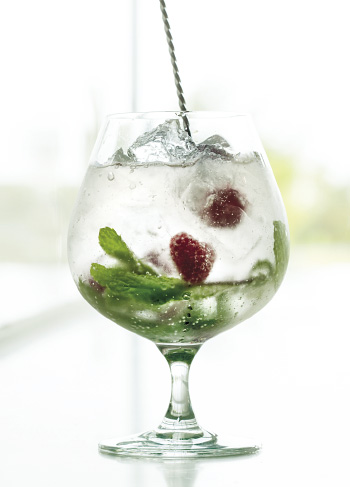 In Cayman’s flourishing drinks scene, there’s one spirit that everyone seems especially giddy about right now: Gin.
In Cayman’s flourishing drinks scene, there’s one spirit that everyone seems especially giddy about right now: Gin.
Once upon a time, the only thing to deliberate when ordering a G&T was whether to have a wedge of lemon or lime. Today, you may well be presented with a more complex equation of novel garnishes (hello, pink peppercorn and lemongrass) and mixers matched to specific distillations, according to their flavor profile.
The trend is an import from Europe and the U.K., where specialist gin and tonic bars, even whole festivals, have become the norm. In 2016, gin sales in Britain grew 16 percent to top $1.04 billion for the first time ever.
Leading the “gin renaissance” in Cayman is Anchor & Den. This summer, the venue introduced a dedicated Gin Booklet to guide guests through its 23-strong collection – reportedly the island’s most extensive – detailing the heritage of each brand, tasting notes, and recommended pairings. It introduced the range at an “All Things Gin” social in May, where attendees sampled their own combinations of gins, mixers (it offers six different tonics), and raw botanicals around an educational experience table.
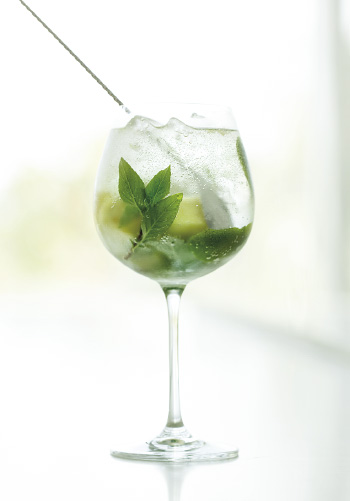 “Getting that essential balance in cooking is key for a chef; it’s the same when it comes to drinks,” says Lee Parry, Anchor & Den’s food & beverage director. “We like to think you wouldn’t mix your red socks in with your white laundry, right? So why pair an exquisite gin with any old tonic? Garnishes should be enhancing the flavor, not covering it up.”
“Getting that essential balance in cooking is key for a chef; it’s the same when it comes to drinks,” says Lee Parry, Anchor & Den’s food & beverage director. “We like to think you wouldn’t mix your red socks in with your white laundry, right? So why pair an exquisite gin with any old tonic? Garnishes should be enhancing the flavor, not covering it up.”
Over at the Kimpton Seafire, a section of Ave’s cocktail menu is devoted to handcrafted Spanish-style gin and tonic options, such as Tanqueray with Thai basil, pineapple, lime, and Indian tonic, and Bulldog with strawberry, tarragon, lemon, and Mediterranean tonic. “Each creation accents the base spirit with different herbs, fruits, or citrus peels, becoming more prominent as they are infused with the spirit and tonic,” explains Director of Food & Beverage, Himanshu Jethi.
This talk of “tasting notes” and “pairings” sounds as if we’ve strayed into fine wine territory, yet gin deserves an equally considered approach: It has one of the most wide-ranging taste profiles of any spirit, from crisp, juniper-laden London Dry such as Bombay Sapphire to a malty, whiskey-esque genever like Bols.
The type of botanicals with which the gin is distilled makes all the difference; the norm is juniper, but there’s been a boom in artisan distillers adding various exotic, distinctive blends of citrus peels, spices, florals, and barks. For example, U.S. brand Bummer & Lazarus ($35.99, Premier Crew) is infused with coriander seed, cinnamon bark, and licorice root for a subtly spicy, earthy profile, while Sipsmith has Angelica root, cassia bark, and ground almond ($39.99, Jacques Scott).
These botanicals usually dictate which garnish will be most complementary – that’s why a cucumber slice seems so right with Hendrick’s, or orange peel in Beefeater. Anchor & Den even makes its own infusions in-house; the intricate copper equipment displayed behind the bar isn’t just for show, you know.
Being selective about which tonic to use also makes sense when you consider this usually comprises two thirds of the drink. Kirk Market and West Indies Wine Company both stock premium brand Fever Tree, which was named “Most Trending Tonic Water” in the World’s 50 Best Bars Annual Report 2016. And in some cases, an alternative mixer is recommended to enhance the drink rather than the classic tonic. For example, London’s Bloom, infused with delicate florals like chamomile and honeysuckle, is better with soda water than a stronger-tasting tonic.
The “Ginaissance” trend even extends to glassware. The traditional high-ball variety is falling out of favor in preference for the Spanish-style “Copa” – a huge balloon-like glass that better captures the aroma of that all-important garnish.
















